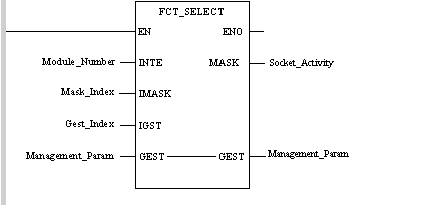|
|
(Original Document)
|


LD Module_Number
FCT_SELECT Mask_Index, Gest_Index, Management_Param, Socket_Activity
FCT_SELECT(Module_Number, Mask_Index, Gest_Index, Management_Param, Socket_Activity);
|
Parameter
|
Type
|
Comment
|
|---|---|---|
|
Module_Number
|
Slot number of network module in rack 0.
|
|
|
Mask_Index
|
Index of first word in the Socket_Activity array
|
|
|
Gest_Index
|
Index of first word in Management_Param array
|
|
Parameter
|
Type
|
Comment
|
|---|---|---|
|
Management_Param
|
ARRAY [0... 3] OF INT
|
For this function, the operation report always returns the value 16#00 indicating that no error has occurred.
|
|
Parameter
|
Type
|
Comment
|
|---|---|---|
|
Socket_Activity
|
ARRAY [0... 1] OF INT
- or -
ARRAY [0... 3] OF INT (Refer to the note in the Function Description topic.)
|
Status of each socket. Each bit set to 1 indicates an event on the socket which corresponds to this bit. For example:
For version 3.3 or earlier:
For versions later than 3.3:
Client Perspective: Once you have a client connection, the corresponding bit for the connection (socket number) is set to 1 in the array. Example: Socket 33 will be found in the third word, first bit (bit 0).
Server Perspective: The listening function opens a socket. This socket number has a corresponding bit set to 1 in the array. Example: Socket 3 will be found in the first word, third bit (bit 2). Then, the Accept function will return a different socket number, and this socket number will have a corresponding bit set to 1 in the array.
NOTE: The listening function socket number bit will remain set to 1 until the socket is closed. |